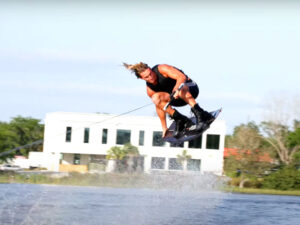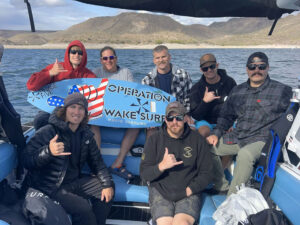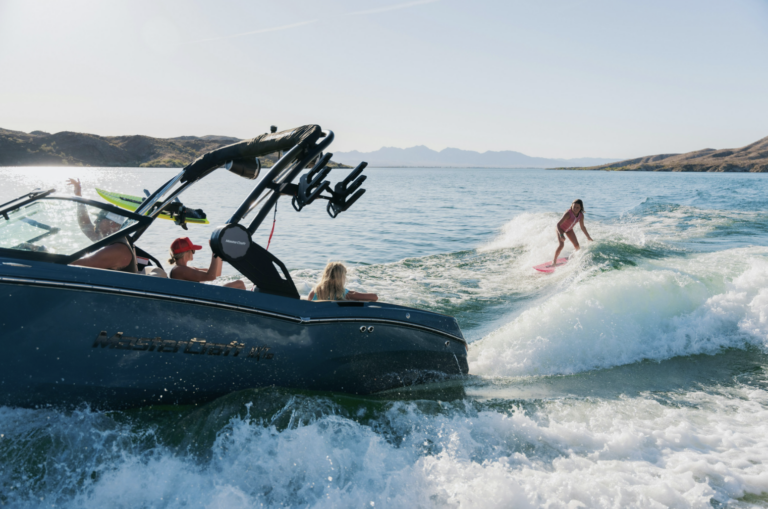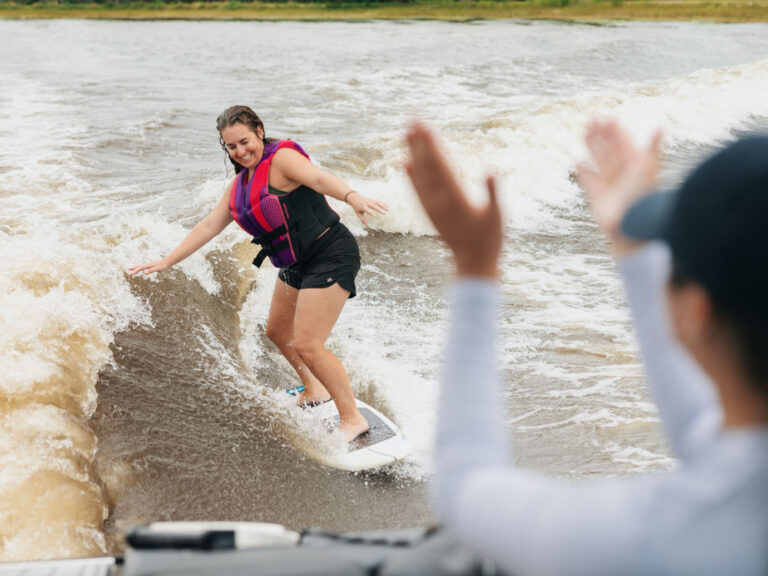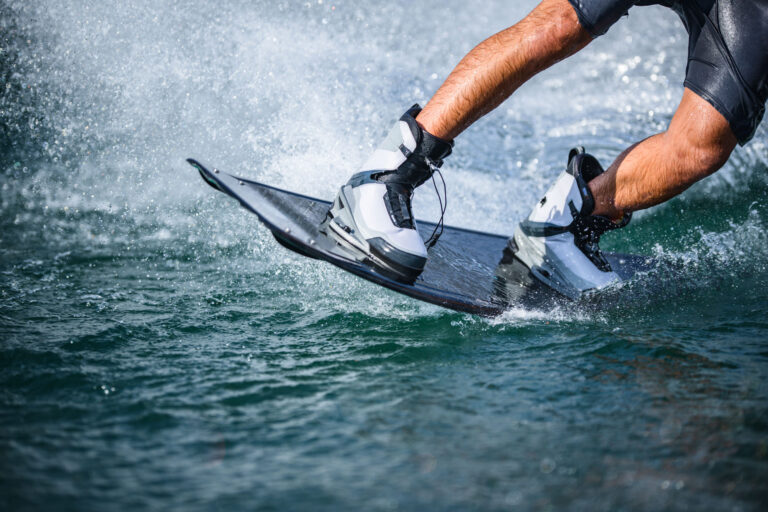The most basic definition of a wakeskate would be: a binding-less wakeboard with smaller fins. Unfortunately, or fortunately as the case may be, this definition doesn’t do the sport justice. Wakeskating is about finesse and style. The board is something that you interact with and ride with, not on. The edge-and-huck mentality that has taken over wakeboarding in the last few years does not apply. Riding without bindings makes you back up and learn the basics like edge control and timing. Even the most basic wakeboarding tricks like jumping the wake are difficult and rewarding.
Ironically, the difficulty of wakeskating is one of the things that makes it so appealing. In Collin Wright’s words, “It’s to the point that it is hard enough that you don’t get all serious about it and can enjoy it for what it is, for the fun of just surfing the wake and doing lip slides.” Other riders like Byerly, Horrell, McGuckin, Smith, Schmaltz, Heer, Murray and Jobe are also into wakeskating in 1998. When you talk to them about it, they talk like kids with a new toy. They’re stoked to tell you what they’re trying and why they like it so much. Byerly says, “I wakeskate whenever I want to get away from regular wakeboarding. It’s fun.”
The mentality of wakeskating is far different from that the rest of the tow sports. It’s more individual and open for personal interpretation than wakeboarding. People don’t wakeskate to impress the crowd with big moves; wakeskating is about self-gratification. The possibilities for technical progression of the riding are unlimited – think wake-to-wake kick flips or taking any of your favorite skate moves and figuring it out behind the boat.
Wakeskating should bring new blood and style into wakeboarding. Byerly says, “It brings more of a skate style into it. It changes the way you look at wakeboarding.” This alternative point of view may change how people choose to interpret wakeboarding in the future. The fact is, when you ride a wakeskate, you have to be smooth; you have to stick your tricks. It helps you stay over your board and learn to use the transitions.
“Wakeskating is all about using everything out there,” Scott Jobe says. On a grander scale wakeskating has the ability to bring people into the sport who would have never considered water-sports as an avenue for their talents, core riders in other boardsports who may have been discouraged or thrown off by the tow-rope aspect of traditional wakeboarding. Hopefully the style and difficulty of wakeskating will influence the technical progression of our sport.
As with any new activity you pick up, you will have to pay your dues. Beginners become painfully aware that wakeskating can be punishing. “You can get ankle biters so bad that you can’t put your wakeboard bindings on for three days,” says Josh Smith. Both Jobe and Smith have small head wounds to vouch for the fact that you can hit your face on the board also. Erich Schmaltz has been knocked out on occasion. Fortunately, as you learn to simply ride the boards, you also learn how to fall in a way that you don’t get hurt.
Beginners need to learn slowly and follow the obvious progression steps. You need to learn to surf a board before you can jump it. Unlike in wakeboarding, you don’t want to try upside-downers the first day; you have to learn to work with the board, start slowly and progress naturally. Learn incrementally: turns first, ollies, then shove-its. If you follow the natural progression, you won’t get into things you can’t handle and get hurt. And if you do fall on your board, as Jason Messer says, “It’s certainly no harsher than bare skin on concrete.”
Another element of wakeskating open to individual interpretation is your board and boat setup. Most wakeskaters use some form of customized boarrd. Josh Smith rides a custom-built 115-centimeter. Horrell and Jobe cut down wakeboards to create their own ideal version, while others just put traction on a stock wakeboard and ride that. Byerly rides a Wake Tech Blunt covered with Astrodeck, while Wright rides a 138 DoubleUP with Fresh Water Pads. All of the wakeskaters go to smaller fins, 1.25 inches or smaller, and most also ride with their rope about 5 feet shorter and drive 1-2 mph slower as well. (Realize that when these guys take 5 feet off their lines they are still riding over 65 feet and going close to 20 mph.) These are only starting points – the nature of wakeskating is to find what works for you.
One technical innovator of wakeskating is Jason Messer. Jason lives in Portland, OR, and has been wakeskating and experimenting with boards and traction for five years. Jason was influenced by the surfing style of Chistian Fletcher in the late 1980s. He admired Christian’s approach – the water as a flowing skate park. “I always used to look at the water and think, how would it be to skateboard on the water,” Jason says. Out of this desire Jason started shaping boards for the specific purpose of wakeskating. “I love the purity of wakeskating. There are no rock stars, no blueprints to follow. Everyone interprets it their own way,” Messer says.
Jason’s company, Fresh Water Traction, produces foam wakeskates and bolt-on traction pads. These boards have a soft foam top and bottom and will save you from excessive pain. Soft boards are the key to the future because they will allow people to push the progression curve even harder. Following Jason’s lead, Hyperlite has two wakeskates in its line for 1998. These boards will have foam tops and hard bottoms and come with Fresh Water’s traction pads.
Wakeskating boards are a matter of personal preference. Because setups are so open to interpretation, wakeskating equipment continues to be a developing science that riders will manipulate over time. The way someone rides a wakeskate is also open to interpretation as each individual chooses. There are no world champs or how-to videos to follow. Every person who participates is on the forefront of the sport. The challenge to master the smallest moves makes the sport fun, yet it is extremely difficult. Binding-less riding is intriguing to a new group of riders who might never have been in a boat before. The development and evolution of wakeskating will push and influence the future of wakeboarding – and contribute to the evolution.


